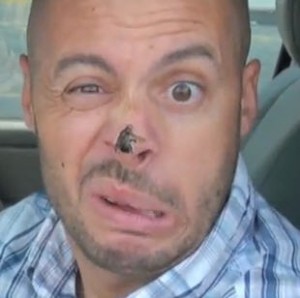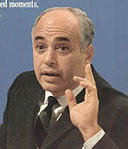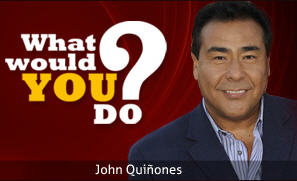Two points an a hug. A very important ingredient to a video prank, and yet one often omitted from online-video pranks. We’ll get to the meaning of “two points and a hug” shortly, and then dovetail surprisingly into a far heavier topic: my view of the painfully unethical television show “What Would You Do?” The victims on this show — whether they provide consent before or after their on-camera failures or successes — are undergoing a cruel psychological experiment that may leave lasting harm.
But first a lighter note. It’s been 4 years since “Farting in Public,” and I’m still learning what elements make that prank succeed and fail. I used to think it was the personal opening (explaining to the viewer so they’re “in” on the prank). Later I assumed it was the off-camera laughter, which can be contagious if real. Now I’m realizing there was a third element I devalued. Notice what occurs at 1:49 (sorry if ad plays, but the link should then play the video at exactly that point).
When I endure the torture of watching someone watch this video (something I loathe), I find them laughing predictably at that moment, which I regretfully buried nearly 2 minutes into the video. The victim laughs. I repeat: the victim laughs.

Now let’s look at Ed Bassmaster, whose pranks have overshadowed mine (and he now dominates most first-level searches for “fart” and “prank.” In particular, notice what occurs 42 seconds in… when Ed persists in complaining about the bee on his noise in an absurd muppet-like tone.
I roared with delight as I watched this non-American struggling to dismiss Ed, as Ed continues to lean toward him with the bee on the face. But then I felt I twinge of guilt because I wondered if my laughter was fueled by the fact that the victim was from another nation (most of the other victims are Americans, and I know for a fact that Ed is opportunistic not calculated on his prank victims).
So there I was with mixed emotions. It was funny, but I wondered if my tear-filled laughter was partially driven by a sense of separateness from the victim. As I say, can there be satire with ire? While it’s not very practical, Ed could have helped be through this dilemma by showing a debrief with the victim… so I knew he was “in on the joke.” Without that, I could only imagine poor Ed standing in a Philadelphia court room as some guy, his attorney and family claims the prank destroyed his life (it’s not a fun place to be, which I offer from personal experience).
 Now, about 350 words later, I arrive at my central message: “two points and a hug.” Remember Candid Camera? Most pranks ended with Allen Funt warmly appearing for “the reveal.” His face alone would bring the victim into laughter, but “smile you’re on candid camera” would seal the deal. Often Funt, and his successors, would point to two of the hidden cameras and embrace the victim with a smile.
Now, about 350 words later, I arrive at my central message: “two points and a hug.” Remember Candid Camera? Most pranks ended with Allen Funt warmly appearing for “the reveal.” His face alone would bring the victim into laughter, but “smile you’re on candid camera” would seal the deal. Often Funt, and his successors, would point to two of the hidden cameras and embrace the victim with a smile.
That “two points and hug” reinforced the tagline: “smile, you’re on Candid Camera.” It served as a clear “consent” from the victim, and made it okay to laugh. Indeed there are gelatophobes who don’t care for pranks even with that soft landing. I worked for one…
Cut to 1992 office of the recently founded and soon-to-bankrupt newspaper, The Georgetown Courier. A recently college graduate named Kevin Nalty convinced his editor to allow him to cover a taping of Candid Camera (the brief 1991-1992 run hosted by Dom DeLuise). My editor, who had known John and Robert Kennedy as friends (and would later scribe a book on the latter), resisted it until I pleaded. “Isn’t it newsworthy that the national television show is hiding in our neighborhood? Wouldn’t our readers love to peek behind the curtain?”
He finally sensed my passion (driven less by my arguments and more by my selfish desire to see the show’s design), and begrudgingly approved me covering the story. It turns out the original show had caught my editor in an airport, where the bathroom sign would lead two a maze of about 12 different doors. By the time Funt arrived to reveal the gag, my editor frowned and told him he didn’t want the moment televised. I suppose he then found a real bathroom and forgot the moment entirely until his green journalist forced the memory back.
If you’re interested, the bit I watched involved naive tailors being summoned to a hotel room to fit a suit. The customer was in handcuffs (a rather frequent comedic device for pranking), and the armed guard would leave the room briefly. As the tailor realized the suit could not be fitted with the handcuffs, the customer would plea for him to unlock the cuffs briefly.

Watching their different responses was fun, as are my own social experiments in pranks. So how can I be so appaulled by the ethical dilemmas featured in “What Would You Do?” The show confronts victims with situations where they can choose action or indifference, and then celebrates or (even by omission) chastises the victims. Would you stop a father from getting his teenager daughter botox? Would you stop a white bike thief? What about a black one? What if she was a blonde?
I’m sorry to report you’re wrong about your answers. There are two ways to view this show, and one is based on an illusion:
- Group A (86%): Most of us may decide we’d “do the right thing,” and take pleasure at watching our fellow “right” comrades. We might even get a mild Schadenfreude buzz taking comfort in the televised shame of those doing “the wrong thing.” You sat and watched a pregnant woman get drunk? I certainly wouldn’t.
- Group B (14%): The second group have studied enough psychology to know the glaring distinction between what we THINK we’ll do (or want to believe we’ll do) and what you actually do. They are as different as January and July. It’s called “the bystander effect,” and was well understood after the murder of Kitty Genovese. She was raped and tortured over 30 minutes as bystanders watched indifferently… each reinforcing the others inaction. The rapist even came back later for 10 more minutes to finish his job. How do you suppose the people felt after realizing their brains had allowed the widespread indifference to contaminate their judgement? Do you suppose there was any among that crowd who would have predicted they’d behave that way?
I would strongly encourage the producers to read the American Psychology Association’s guidelines on ethical psychological testing, since that’s what the show is basically doing. We do many things daily that contradict our values, and getting “caught” missing an opportunity to do “the right” thing can leave deep emotional scars... whether it’s televised or not. Hopefully the damage of a few can be offset by our raising our consciousness of the “bystander effect,” although no show has seemed to take that effort yet. At the very least, maybe someone will behave the “right way” just in case Quinones and his cameras is nearby.
But when John Quinones shows up, you’re about the be portrayed as a hero or villain. You may get the two points, but unlikely a hug that feels very good.

I feel bad for the people on What would you do. I always say I’ll do the right thing but when push comes to shove I think I choose not to get involved.
this is interesting – and not totally unrelated to this new feature I complained about on the youtube google forum thingy whatever they call it
http://www.google.com/support/forum/p/youtube/thread?tid=4821c696143d523f&hl=en
It’s kind of creepy to have your channel targeted, whether by deign or at random – without being asked first.
On the topic – they’ve already altered the WTF option – can’t even imagine what 14 year was working on that part of the project.
Then there’s the whole marketing data they will be gleaning – which is what I think this is probably all about anyway.
and finally what options the users will have in turning this thing on and off without losing other features like up and down.
I kinda felt like I was on candid camera after this experience. Surprised by not being aware – then finding out it was a joke or some experiment, but not really.
Well would you look at that!!
A couple of months ago I was walking w/ hank through our complex near a couple of kids who looked to be about 12 years old. As we approached, one kid bent down and said ‘dude, I just found a book of matches!’ and then picked them up. The other kid went over to look at them as we walked past. I walked about 10 feet, turned around, walked back, stuck out my hand and said ‘give them to me. Matches are not for children.’ I was actually shocked that they handed them over without a word. I wish john quinones had been there, because I would not only have gotten my positive affirmation, I would have immediately started whoring out all my social media sites. And then done a match.com video.
sukatra that was very funny you should vlog
You Should Google Trigger Happy TV. The Original British Version. Especially The Big Phone Guy. Sometimes the stuff is painful to watch but hilarious.
Someone has collected some of the Big Phone Guy vidoes HERE
They guy does other Funny pranks, but the Big Phone Guy is definitely the Best.
Jan ill vlog when you vlog
jischinger, I just got the email that of your comment about the “Your Reaction” Feature.
Is it a real feature? I do not see it on the Videos on either CosmicPanda or Original. Maybe it just has not been rolled out to my local server farm. It looks like it is on the Original layout.
I see what they are doing. Instead of just “Trending” they are going to have different types of Trending. Oh wait!
They have combined Nalt’s and Mine Ideas. Nalt’s Breakdown of Type of Video and reaction and My “YouTube Moments”
It will be interesting to see how the Trolls take advantage of this system though.